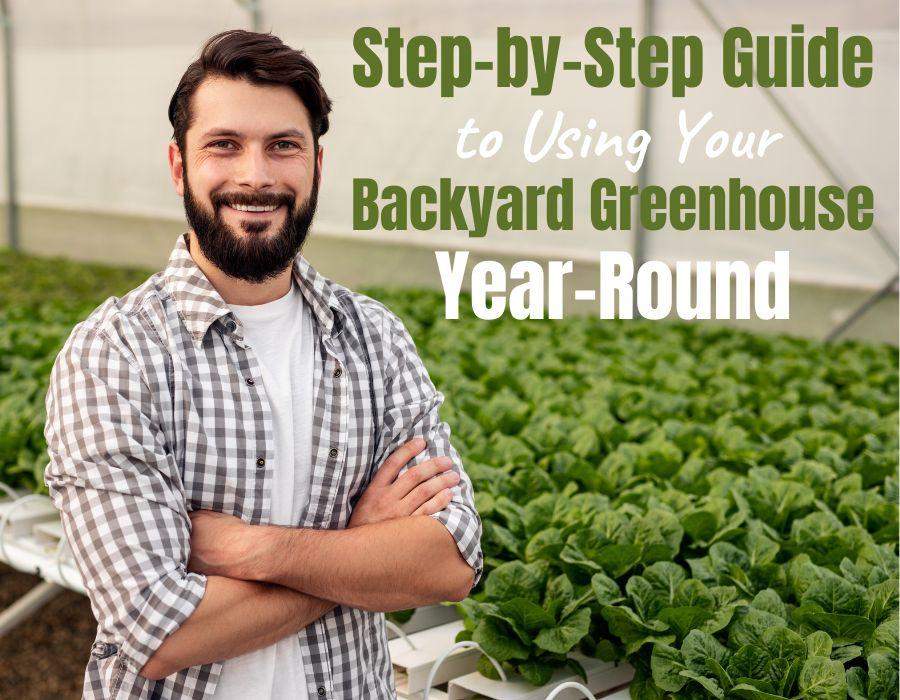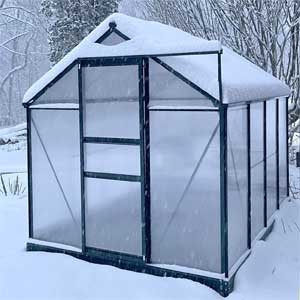Yes, you can use a greenhouse year-round. With proper insulation and heating systems, you can create an ideal environment for plants even during colder months. This allows for continuous growth and cultivation of various crops regardless of the season.

Can a Greenhouse Kit Handle Snow & Wind?
When considering whether a hobby greenhouse kit will withstand wind, snow and various weather conditions, it’s important to assess the materials used and the design features that can optimize its performance in cold weather. Let’s break down these factors:
1. Greenhouse Materials:
A. Frame Material
- Aluminum: Many well-made greenhouse kits use aluminum frames. Aluminum is lightweight, rust-resistant, and durable. It can withstand exposure to moisture and temperature variations.
- Galvanized Steel: Some kits may feature galvanized steel frames, which are strong and corrosion-resistant. These are suitable for areas with harsh weather conditions.
B. Glazing Material
- Polycarbonate Panels: These are commonly used for greenhouse walls and roofs. Twin-wall or multi-wall polycarbonate provides insulation, which helps retain heat and protect against cold temperatures.
- Glass: Some higher-end kits may feature tempered or double-paned glass. While glass provides excellent insulation, it can be heavier and more susceptible to breakage in severe weather.
C. Fasteners and Hardware
Check that the kit includes quality fasteners and hardware that can withstand exposure to moisture and temperature changes without rusting or corroding.
2. Design Features to Optimize Cold Weather Performance:
Roof Pitch: A steeper roof pitch allows snow to slide off more easily, reducing the risk of accumulation and potential roof damage. A minimum pitch of 30 degrees is often recommended for snow-prone areas.
Snow Load Rating: Check the greenhouse kit’s snow load rating. It should be designed to handle the typical snow loads in your region. Higher-rated kits can withstand heavier snow accumulation.
Wind Resistance: Look for features like bracing, crossbars, or additional structural supports that enhance the greenhouse’s wind resistance. Proper anchoring to the foundation is crucial to prevent the structure from tipping over in strong winds.
Insulation: To optimize cold weather performance, choose a pre-fab greenhouse kit with good insulation properties. Polycarbonate panels with multiple layers provide better insulation and help retain heat during chilly nights.
Ventilation and Temperature Control: Adequate ventilation is essential to prevent overheating during sunny winter days. Look for adjustable roof vents, louvers, and automated ventilation systems to manage temperature and humidity levels.
Heating Options: Consider how you will heat your greenhouse during cold weather. Some kits may include options for adding heating elements or can accommodate electric or gas heaters.
Foundation: Make sure that the framing is securely anchored to a solid foundation to prevent it from shifting or tilting due to frost heave.
Sealants and Weatherstripping: Properly seal all gaps and joints with weather-resistant sealants and weatherstripping to minimize heat loss and drafts.
Site Selection: Choose a location for your greenhouse that offers protection from harsh winds, if possible, and maximize exposure to sunlight.

How do I Winterize My Greenhouse?
Preparing your plant nursery for winter or extreme weather is crucial to protect your plants, maintain a suitable growing environment, and safeguard the structure itself. Here are some essential steps and considerations for getting your gardening area ready for colder temps:
1. Clean and Organize:
Start by thoroughly cleaning the interior, removing any debris, dead plants, and weeds. A clean space is easier to work in and helps reduce potential pest and disease problems.
Note: Keep essential supplies on hand, including extra glazing materials, heating fuel and replacement parts for equipment.
2. Check for Leaks and Repairs:
Examine the structure for any signs of damage, including leaks, broken glass or panels, and damaged frames. Repair or replace any damaged parts to achieve a tight seal and structural integrity.
Note: Check that the greenhouse is securely anchored to its foundation to prevent damage from strong winds or heavy snow loads.
3. Insulation:
Insulate the greenhouse to retain heat during frigid weather. Common sheltering methods include:
- Adding a layer of bubble wrap or thermal blankets to the walls and roof.
- Applying weatherstripping to seal gaps around doors and vents.
- Using insulated, double-walled polycarbonate panels for glazing.
Note: Use frost blankets or row covers to protect sensitive plants on particularly cold nights and snugly secure these coverings to prevent heat escape.
4. Heating & Ventilation:
Install a warming system if your greenhouse lacks one. For example, options include electric heaters, propane heaters or radiant flooring. Keep in mind that you want to attain proper ventilation to prevent overheating.
Adequate ventilation is crucial, even in winter. Use roof vents, side vents, or automatic louvers to regulate temperature and humidity. Proper airflow helps prevent mold and mildew issues.
Note: During sunny winter days, the greenhouse can overheat. Install shade cloth to protect plants from excessive sunlight and heat.
5. Water Management:
Adjust your watering schedule to account for reduced plant growth in winter. In addition, you want good drainage to prevent waterlogged soil.
6. Cold-Hardy Plants:

Consider growing cold-hardy plants that can withstand lower temperatures without additional heating. These may include winter vegetables, herbs or ornamental plants.
In addition, you may want to invest in a greenhouse monitoring system that tracks temperature, humidity and other factors. This allows you to receive alerts and make adjustments remotely if needed.
7. Snow & Ice Removal:
I cannot stress enough the importance of regularly removing snow and ice from your greenhouse roof to prevent structural damage. Snow and ice accumulation can significantly increase the load on the greenhouse structure, particularly on the roof, leading to potential collapse if not properly managed.
To safely remove snow and ice, I recommend using a soft broom or a long-handled tool specifically designed for this purpose. These devices strategically help you clear the roof without damaging the glazing material, whether it’s glass or polycarbonate. It’s crucial to use gentle, sweeping motions to avoid scratching or applying too much pressure, which could crack or break the panels.
Additionally, when designing or selecting a greenhouse, consider opting for a roof with a steeper pitch, which helps snow slide off more easily, reducing the likelihood of heavy accumulation. Regular maintenance and proactive snow removal are key to enjoying the benefits of year-round greenhouse gardening without the risk of structural issues.
Note: In regions with severe weather conditions, consider having a backup power source to ensure heating and ventilation systems continue to function during power outages.
Do I Need to Add Supplemental Light in My Greenhouse During Winter?
The decision to add supplemental light during winter depends on your location, plant types, greenhouse design and growth goals. First, assess your nursery’s natural light conditions and the specific requirements of your plants.
1. Location and Daylight Availability:

The amount of natural daylight your greenhouse receives during the winter months depends on your geographic location. As you’d expect, northern regions get less daylight and lower sun angles in winter, which can significantly impact plant growth.
Assess the light levels in your garden during the winter. If you notice that light levels are consistently low or that plants are not getting adequate light for healthy growth, supplemental lighting may be necessary.
2. Plant Types and Growth Goals:
Some plants can tolerate low-light conditions, while others require more sunlight for growth and flowering. Consider the types of plants you’re cultivating and your growth goals.
For example, if you’re growing cold-season crops like winter vegetables or ornamental plants that naturally thrive in cooler, lower-light conditions, supplemental lighting may be less critical.
3. Greenhouse Design and Glazing:
I’ve learned through experience the importance of thoughtful design in optimizing a greenhouse for year-round use. The orientation should ideally face south in the northern hemisphere to maximize sunlight exposure, especially in winter.
Choosing the right glazing material is crucial: polycarbonate panels offer excellent insulation and light diffusion, while glass provides clarity and can be made more insulative with multiple panes. Proper insulation, use of reflective materials, and incorporating thermal mass like water barrels can help maintain consistent temperatures.
Additionally, effective ventilation is essential for controlling humidity and ensuring adequate carbon dioxide for photosynthesis. These design considerations are key to creating an efficient and productive greenhouse environment.
4. Types of Supplemental Lighting:
Common supplemental lighting options for greenhouses include high-intensity discharge (HID) lights like metal halide and high-pressure sodium lamps, fluorescent lights and LED grow lights.
In addition, energy-efficient LED grow lights are energy efficient, have a customizable light spectrum and produce less heat.
Note: Different plant growth stages require varying light spectrums. LEDs offer the flexibility to adjust the light spectrum to meet specific plant needs.
5. Light Duration and Timing:
It’s essential to tailor the duration and timing of supplemental lighting to the specific needs of each plant species, typically ranging from 12 to 16 hours per day. Consider the natural light conditions of your location and the time of year, using timers to maintain consistent light cycles critical for plant health.
LED lights are especially advantageous due to their energy efficiency and adjustable light spectrum, allowing customization for optimal growth and flowering of various plants. Regularly adjusting your lighting strategy based on seasonal changes and plant responses will ensure your greenhouse remains an effective environment for plant cultivation year-round.
Note: Make sure that that supplemental lights are evenly distributed to prevent uneven plant growth and stretching toward the light source.
6. Energy Costs:
Operating a backyard greenhouse year-round involves managing energy costs, particularly for lighting. LED lights, while energy-efficient, can still significantly impact your electricity bills, especially during shorter winter days when they may need to run up to 16 hours.
Costs can vary based on the greenhouse size, local energy rates, and the effectiveness of your insulation. To potentially reduce expenses, consider using timers for off-peak hours and integrating renewable energy sources like solar panels. Understanding these factors will help in optimizing the cost-effectiveness of your greenhouse operations.
Summary:
In conclusion, utilizing your greenhouse year-round is entirely feasible with the right preparation and adaptations. By investing in durable materials, optimizing design features for extreme weather and implementing effective insulation and heating systems, you can create a sustainable environment for a wide range of plants regardless of seasonal changes.
Last Updated April 25, 2024





